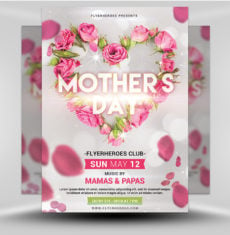Gold Mask Mardi Gras Flyer Template
There’s one party that always trumps them all… one party that takes the term ‘party’ and elevates it to a whole new level. This is a party where anything goes – and usually does. It’s Mardi Gras, and if you own a club, a restaurant, or you’re just looking to throw the most epic of parties, you’ve got to promote with the Gold Mask Mardi Gras Flyer Template from FlyerHeroes! This flyer was designed by our incredible FlyerHeroes team and is ready for purchase right now. Featuring the bright and colourful Mardi Gras palette, the Gold Mask Mardi Gras Flyer Template is sure to grab the attention of those looking to let off a little steam this March! Customize this flyer to your liking! Change the text to reflect the details of your Mardi Gras shindig and add in the date, the time and location as well as your social media handles hashtags! Mardi Gras is always one hell of a party, but make this year’s unforgettable with the Gold Mask Mardi Gras Flyer Template from FlyerHeroes!
Don’t settle for second best! If this isn’t your number one pick, we’ve got plenty of other Mardi Gras flyer options, so take a look around! Check out the fun and exciting Mardi Gras After Party Flyer Template, or the totally rad Mardi Gras Party Flyer Template 2! There’s more where that came from, so take a peek!
Once purchased, you are free to make any customizations and modifications, and are granted Unlimited Use and 100% Free License. See more here.
Please note all stock models/photographs of people are not included in final download. Feel free to use you own.
View related Mardi Gras Flyer Templates:
- Mardi Gras 2017 Flyer Template
- Shrove Tuesday Flyer Template
- Mardi Gras After Party Flyer Template
- Golden Mardi Gras Flyer Template 2
What fonts do I need for this template?
General information:
Gold Mask Mardi Gras Flyer Template is a premium Photoshop PSD flyer / poster template designed by FlyerHeroes to be used with Photoshop CS4 and higher.
Once you have purchased this flyer template, you are free to make any customizations and modifications you wish.
You are also granted an Unlimited Use and 100% Royalty Free License meaning you can use this product as many times as you wish for as many clients as you wish. You are free to use this product in both personal and commercial work.
You can read more on our File Licenses here and our File Requirements here.
Please note, stock models / photographs of people are used for demonstration purposes only and are not included in the final download. We do however include a blank placeholder layer to make using your own stock photos as easy as possible.
If you have any further questions, please feel free to direct your questions to FlyerHeroes Support.

















